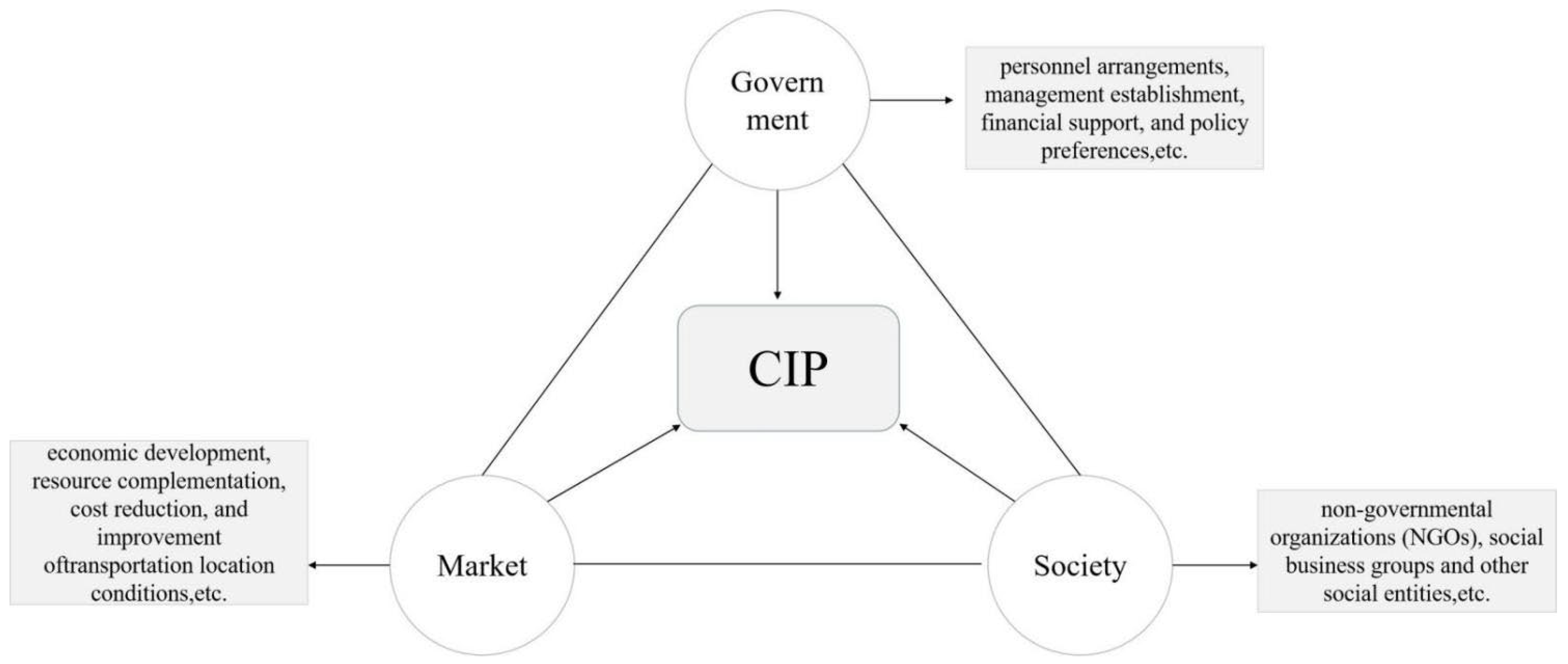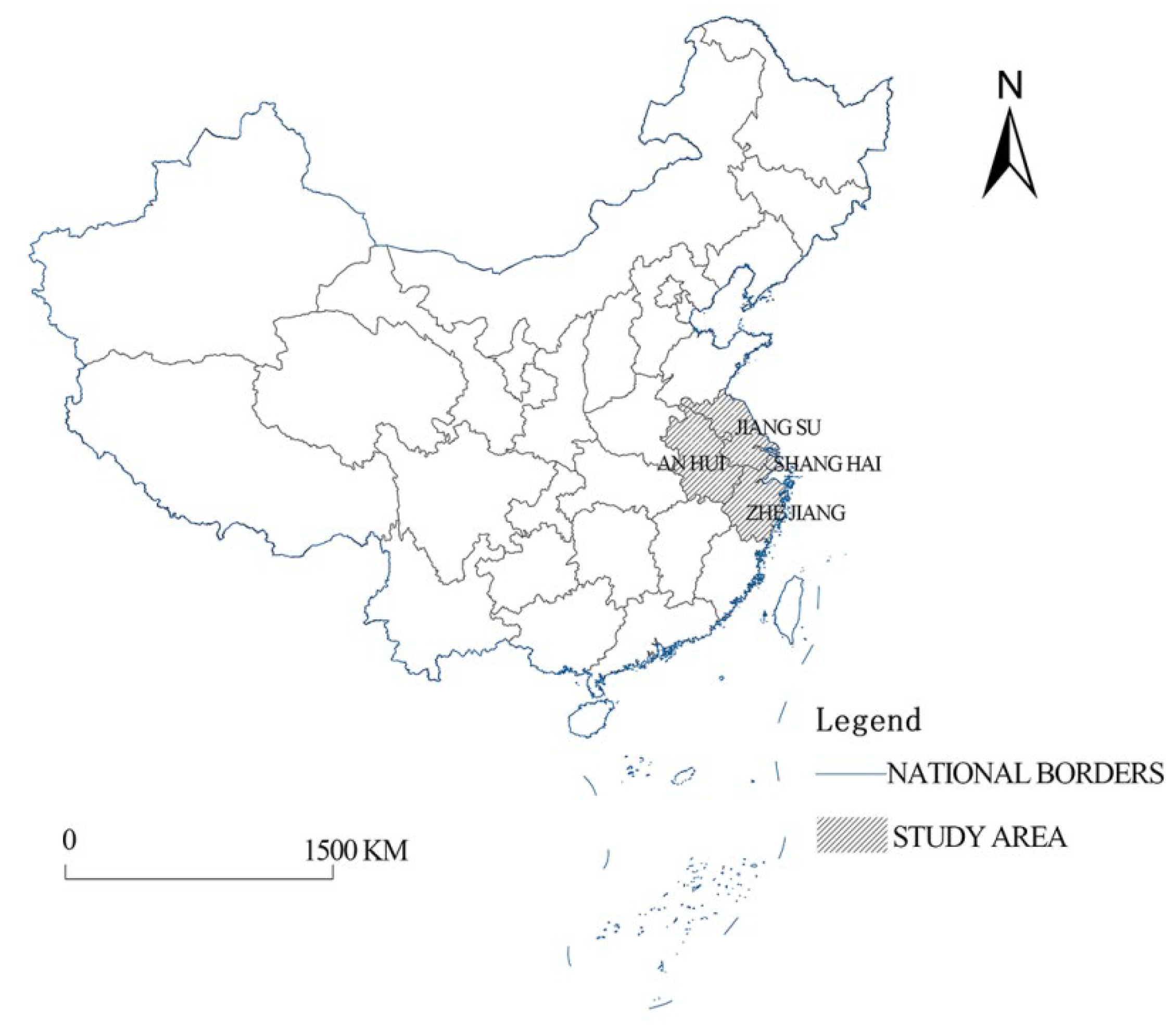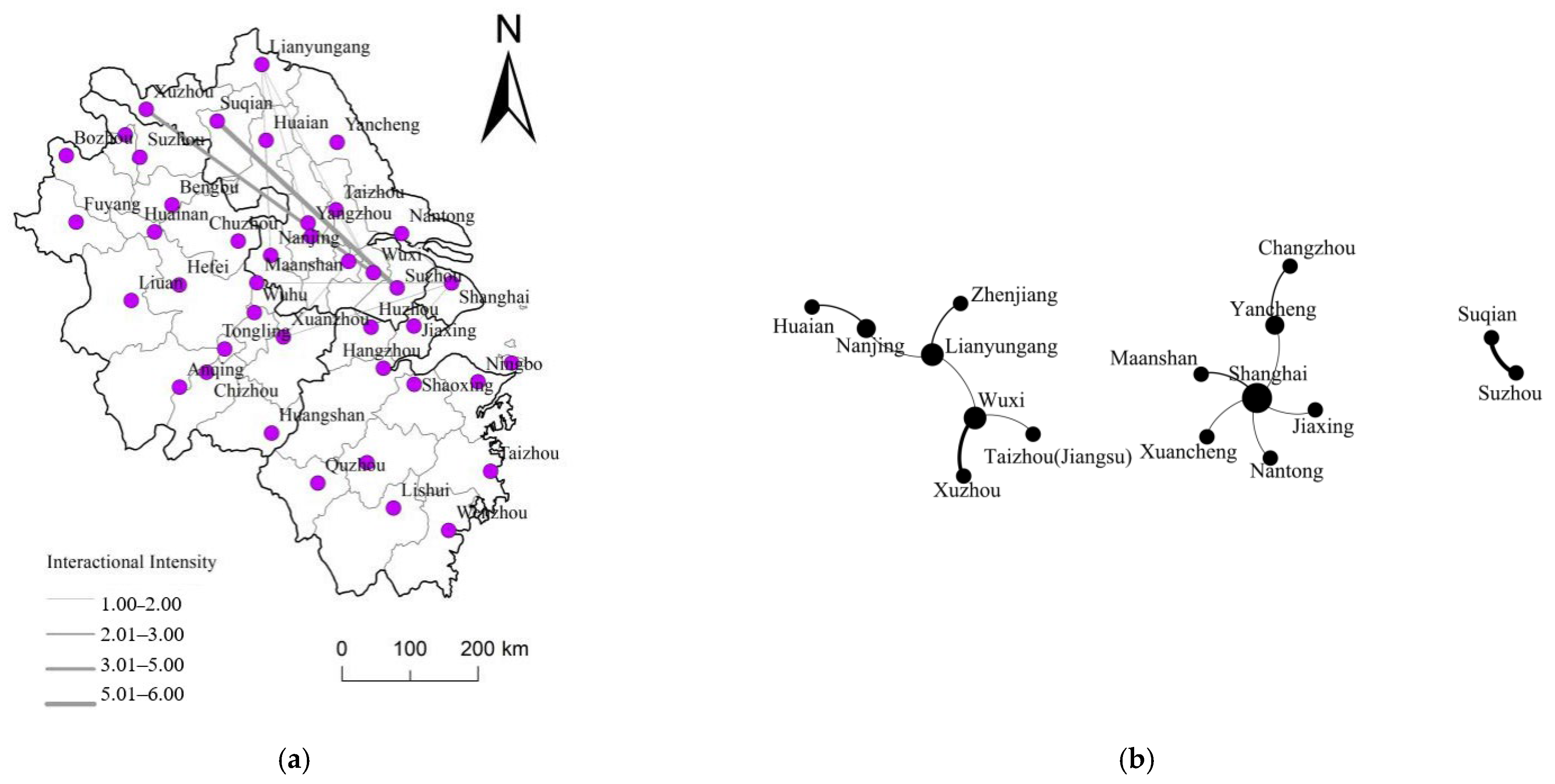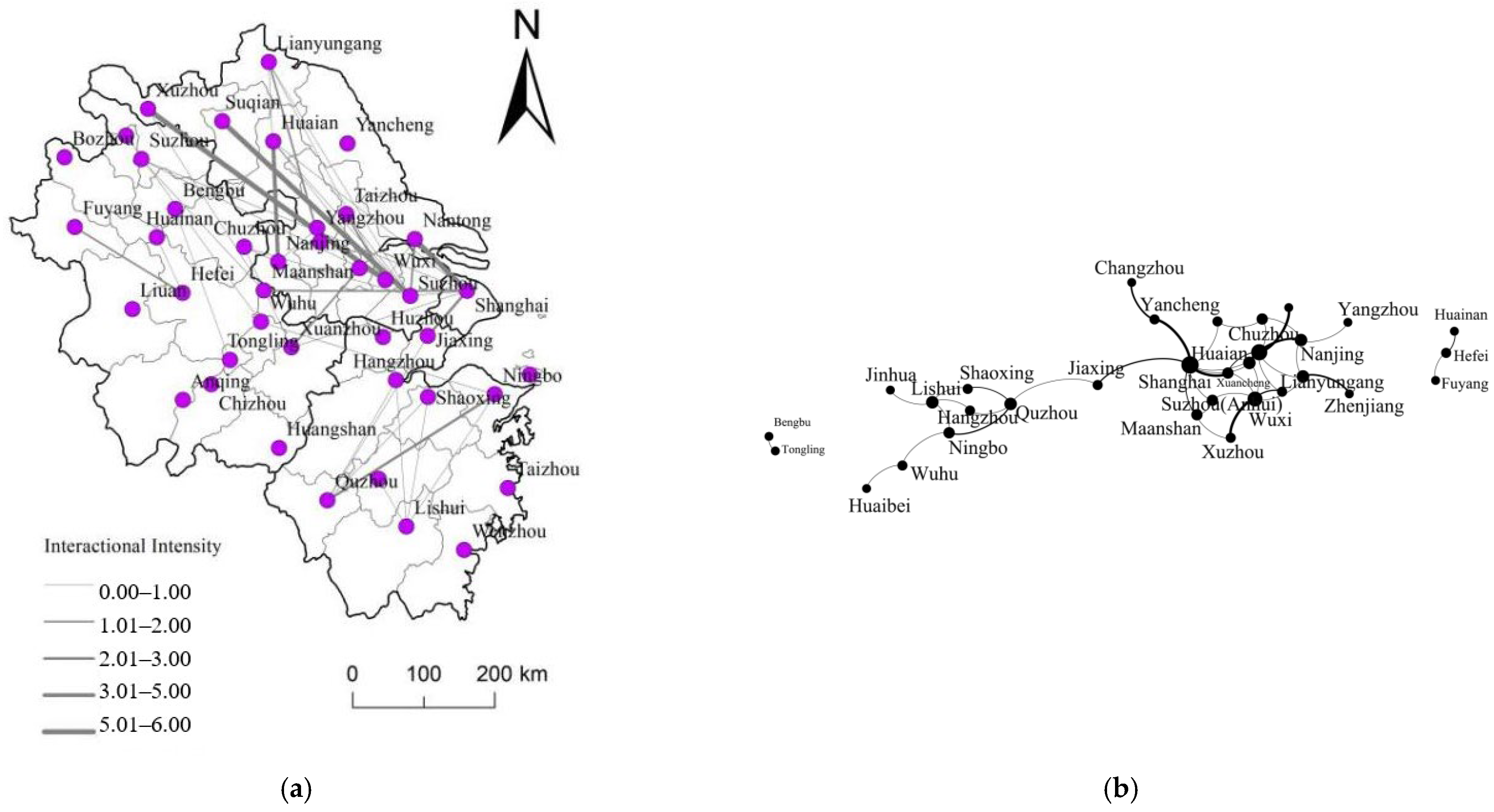Cross-Regional Cooperation and Counter-Market-Oriented Spatial Linkage: A Case Study of Collaborative Industrial Parks in the Yangtze River Delta Region
Abstract
:1. Introduction
2. Literature Review
2.1. CIP and “Enclave Economy”
2.2. Dynamic Mechanism of CIP
3. Methodology
3.1. Two-Way Fixed Effects Model
3.2. Complex Network Analytical Method
3.3. Study Area and Data Sources
4. Results
4.1. Spatiotemporal Distribution Characteristics of CIP
4.1.1. Exploration Period of CIPs
4.1.2. “Blowout” Development Period of CIPs
4.1.3. The Complete Cluster Formation Period of CIPs
4.2. Driving Mechanism of the Geographical Expansion of CIPs
4.2.1. Impact of Local System Experiment and National Spatial Choice on the Geographic Expansion of CIPs
4.2.2. Impact of the Market, Social, and other Factors on the Geographic Expansion of CIP
4.2.3. Robustness Tests
5. Conclusions and Discussions
5.1. Conclusions
5.2. Discussions
Author Contributions
Funding
Institutional Review Board Statement
Informed Consent Statement
Data Availability Statement
Conflicts of Interest
References
- Chen, C.L.; Peter, H. The impacts of high-speed trains on British economic geography: A study of the UK’s intercity 125/225 and its effects. J. Transp. Geogr. 2011, 19, 689–704. [Google Scholar] [CrossRef]
- Yang, C. Multilevel governance in the cross-boundary region of Hong Kong Pearl River Delta, China. Environ. Plan. A 2005, 37, 2147–2168. [Google Scholar] [CrossRef]
- Luo, X.; Shen, J. A Study on inter-city cooperation in the YRDR, China. Habitat Int. 2009, 33, 52–62. [Google Scholar] [CrossRef]
- Shen, J. Not quite a twin city: Cross-boundary integration in Hong Kong and Shenzhen. Habitat Int. 2014, 42, 138–146. [Google Scholar] [CrossRef]
- Li, Y.; Wu, F. Towards new regionalism? Case study of changing regional governance in the Yangtze River Delta Region. Asia Pac. Viewp. 2012, 53, 178–195. [Google Scholar] [CrossRef]
- Li, Y.; Wu, F. Understanding city-regionalism in China: Regional cooperation in the YRDR. Reg. Stud. 2018, 52, 313–324. [Google Scholar] [CrossRef]
- Shang, H.; Jiang, L.; Pan, X.F. Does R&D element flow promote the spatial convergence of regional carbon efficiency? J. Environ. Manag. 2022, 322, 116080. [Google Scholar]
- Rapih, S. The US vs. the EU: Cross-border bank flows’ origin factor and shadow banking in emerging market economies. Appl. Econ. Lett. 2022, 29, 1266–1270. [Google Scholar] [CrossRef]
- Li, L.Q.; Ma, X.G.; Lu, Y. The production and governance structure of enclave economy: From the perspective of state spatial restructuring. Prog. Geogr. 2019, 38, 346–356. [Google Scholar]
- Gallagher, K.P.; Zarsky, L. The Enclave Economy: Foreign Investment and Sustainable Development in Mexico’s Silicon Valley; The MIT Press: Cambridge, MA, USA; London, UK, 2007. [Google Scholar]
- Bustos-Gallardo, B. The post 2008 Chilean Salmon industry: An example of an enclave economy. Geogr. J. 2017, 183, 152–163. [Google Scholar] [CrossRef]
- Hanna, B. Enclaves, borders, and everyday movements: Palestinian marginal mobility in East Jerusalem. Cities 2016, 59, 173–182. [Google Scholar]
- Perkmann, M. Construction of new territorial scales: A framework and case study of the EUREGIO cross-border region. Reg. Stud. 2007, 41, 253–266. [Google Scholar] [CrossRef]
- Gu, X.K.; Xie, B.M.; Zhang, Z.; Guo, H.D. Rural multifunction in Shanghai suburbs: Evaluation and spatial characteristics based on villages. Habitat Int. 2019, 92, 102041. [Google Scholar] [CrossRef]
- Lian, L.; Ye, X.T. Research on enclave economy in the coordinated development of Jingjinji region. Inq. Into Econ. Issues 2016, 146–151. [Google Scholar]
- Wang, S.B.; Luo, X.L. The evolution of government behaviors and urban expansion in Shanghai. Land Use Policy 2022, 114, 105973. [Google Scholar]
- Jiang, F.W.; Luo, X.L. Analysis to the cooperative modes of industrial parks: A case study on Jiangsu Province. Urban Probl. 2016, 35, 38–43. [Google Scholar]
- Phelps, N.A.; Miao, J.T.; Zhang, X. Polycentric urbanization as enclave urbanization: A research agenda with illustrations from the Yangtze River Delta Region (YRDR), China. Territ. Politics Gov. 2020, 9, 1851750. [Google Scholar] [CrossRef]
- Kim, S.K.; Terry, G.V.; Paul, J.; Mia, M.B. Transboundary air pollution and cross-border cooperation: Insights from marine vessel emissions regulations in Hong Kong and Shenzhen. Sust. Cities Soc. 2022, 80, 103774. [Google Scholar] [CrossRef]
- Rui, A.C.; Ana, V.; José, C.F.; Luis, F.P.; José, M.N.G.; Luís, C.L. Accessibility and connectivity—Movement between cities, as a critical factor to achieve success on cross-border cooperation (CBC) projects. A European analysis. Sust. Cities Soc. 2017, 32, 181–190. [Google Scholar]
- Xin, J.; Gideon, B.; Pieter, H. Africans in Guangzhou: Is the ethnic enclave model applicable in the Chinese context? Cities 2021, 117, 103320. [Google Scholar]
- Wen, X.Z. Breaking the duke economy: From development zones to enclave economy. Sci. Technol. Ind. Parks 2004, 20–21. [Google Scholar]
- Liu, Y.J.; Luo, X.L.; Tian, D.; Wang, Y. Preliminary study on China’s cross- boundary new district in forming mechanisms, spatial organizations and governance models. Econ. Geogr. 2014, 34, 41–47. [Google Scholar]
- Zhu, H.; Li, G. Modes and Features for Regional Cross-border Cooperation. Urban Plan. Int. 2015, 30, 67–71. [Google Scholar]
- Wu, F. China’s emergent city-region governance: A new form of state spatial selectivity through state-orchestrated rescaling. Int. J. Urban Reg. Res. 2016, 40, 1134–1151. [Google Scholar] [CrossRef]
- Zhang, J.X. Scale rescaling of regional governance:Based on the analysis of the perspective of “national strategic regional planning”. Urban Dev. Stud. 2013, 20, 45–50. [Google Scholar]
- Chen, W.; Yang, L.; Zhang, P. Types, obstacles, and governance paths of regional cooperation in the YRDR. City Plan. Rev. 2021, 45, 1–6. [Google Scholar]
- Kwon, S.W.; Park, S.C. Metropolitan governance: How regional organizations influence interlocal land use cooperation. J. Urban Aff. 2014, 36, 925–940. [Google Scholar] [CrossRef]
- Qin, X.F.; Li, Y.R.; Lu, Z.; Pan, W. What makes better village economic development in traditional agricultural areas of China? Evidence from 338 villages. Habitat Int. 2020, 106, 102286. [Google Scholar] [CrossRef]
- Andrew, C.; Doloreux, D. Economic Development, Social Inclusion and Urban Governance: The Case of the City-Region of Ottawa in Canada. Int. J. Urban Reg. Res. 2012, 36, 1288–1305. [Google Scholar] [CrossRef]
- Hu, J.; Sun, J. Research of the regional governance model of YRDR from the perspective of state-regional scale rescaling. Urban Plan. Forum 2020, 259, 77–83. [Google Scholar]
- Li, S.B.; Li, X.M.; Tian, C.; Cong, X. Exploration of the Residents’ Quality of Life Based on the Distance of Public Service Facilities: Case of Dalian. J. Urban Plan. Dev. 2021, 147, 3121001. [Google Scholar] [CrossRef]
- Smith, N. Uneven Development: Nature, Capital, and the Production of Space; Basil Blackwell: Oxford, UK, 1990. [Google Scholar]
- Wang, S.B.; Luo, X.L.; Tang, M.; Liu, J.F. Development of cross-border integration of Beijing and Shanghai based on symbiosis theory. Sci. Geogr. Sin. 2019, 39, 1681–1690. [Google Scholar]
- Zhang, B.C.; Ren, H.; Tong, X. Research on the Motivation and Mode of Industrial Cooperation Park. Mod. Manag. Sci. 2017, 24–27. [Google Scholar]
- Scholvin, S. World cities and peripheral development: The interplay of gateways and subordinate places in Argentina and Ghana’s upstream oil and gas sector. Growth Change 2021, 52, 111–129. [Google Scholar] [CrossRef]
- Clément, C.; Xavier, D.H. Two-Way Fixed Effects Estimators with Heterogeneous Treatment Effects. Am. Econ. Rev. 2020, 110, 1–35. [Google Scholar]
- Liu, Y.J.; Zhou, G.L.; Liu, D.G.; Yu, H.S.; Zhu, L.Y.; Zhang, J. The interaction of population, industry and land in process of urbanization in China: A case study in Jilin Province. Chin. Geogr. Sci. 2018, 28, 529–542. [Google Scholar] [CrossRef] [Green Version]
- Liu, F.; Zhang, Z.X.; Zhao, X.L.; Liu, B.; Wang, X.; Yi, L.; Zuo, L.J.; Xu, J.Y.; Hu, S.G.; Sun, F.F.; et al. Urban Expansion of China from the 1970s to 2020 Based on Remote Sensing Technology. Chin. Geogr. Sci. 2021, 31, 765–781. [Google Scholar] [CrossRef]
- Lee, D.W.; Lee, D.S. Analysis of Influential Factors of Violent Crimes and Building a Spatial Cluster in South Korea. Appl. Spat. Anal. Policy 2020, 13, 759–776. [Google Scholar] [CrossRef]
- Guo, J.K.; Wang, S.B.; Wang, D.D.; Liu, T.B. Spatial Structural Pattern and Vulnerability of China-Japan-Korea Shipping Network. Chin. Geogr. Sci. 2017, 27, 697–708. [Google Scholar] [CrossRef]
- Huallacháin, B.Ó.; Lee, D. Urban centers and networks of co-invention in American biotechnology. Ann. Reg. Sci. 2014, 52, 799–823. [Google Scholar] [CrossRef]
- Liu, Z.L.; Gu, H.Y. Evolution Characteristics of Spatial Concentration Patterns of Interprovincial Population Migration in China from 1985 to 2015. Appl. Spat. Anal. Policy 2020, 13, 375–391. [Google Scholar] [CrossRef]
- Pang, M.B.; Chen, C.; Ma, L.X. Bilevel Mixed Land Use-Transportation Model Based on Urban Road Network Balance. J. Urban Plan. Dev. 2021, 147, 4021048. [Google Scholar] [CrossRef]
- Chen, X.; Zhong, R. Cross-boundary coordination plan: A new exploration on regional governance: A case study of Jiangsu Province. Urban Plan. Int. 2017, 41, 24–29. [Google Scholar]
- Chan, R.C.K.; Xian, S. Assessing The Incentivesin Regional City-to-City Cooperation:A Case Study of Jiang yinJing jiang Industrial Park of Jiangsu Province in the YangtzeRiver Delta Region. Asia Pac. View Point 2012, 53, 56–69. [Google Scholar] [CrossRef]
- Zhang, P.; Chen, W.; Wu, J.W.; Yuan, F. Research Progress and Prospects of Cooperation Zones: Cooperation Type, Cooperation Motivation, and Cooperation Effect. Trop. Geogr. 2020, 40, 589–603. [Google Scholar]
- Brenner, N. New State Spaces: Urban Governance and the Rescaling of Statehood; Oxford University Press: Oxford, UK, 2004. [Google Scholar]
- Zheng, Y.T.; Xu, W.T.; Dai, L.Z. Urban growth in a post-2000 central Chinese urban agglomeration: Case study of the Changzhutan region. Growth Chang. 2021, 51, 464–487. [Google Scholar] [CrossRef]





| Variable | Variable Group | Variable Name | Symbol | Index Calculation |
|---|---|---|---|---|
| Dependent variable | Degree | Degree | K | |
| Independent variable | Residents’ living standards | The degree of population agglomeration | popu | Total population at the end of the year/land area of administrative area |
| Wage level | wage | Log value of total wages of employees | ||
| Housing price level | house | Average price of urban housing | ||
| The foundation of urban development | Economic development level | gdp | Log value of GDP | |
| Financial development level | finance | Log value of the balance of loans of financial institutions at the end of the year as a percentage of GDP | ||
| Industrial structure | sec | The added value of the secondary industry as a percentage of GDP | ||
| Urban traffic conditions | Highway passenger traffic | passenger | The ratio of highway passenger traffic to the total population at the end of the year | |
| Highway freight traffic | freight | The ratio of road freight volume to total population at the end of the year | ||
| The number of taxis | taxi | The log value of taxis | ||
| City’s investment intensity | The number of employees | labor | Log value of the number of employees in urban units at the end of the period | |
| The level of human capital | hum | Log value of the ratio of the number of ordinary undergraduates and junior college students to the total population at the end of the year | ||
| Government scientific research support | govrd | Log value of the ratio of science and technology expenditure to budget expenditure |
| Region | Type | Number | Region | Type | Number |
|---|---|---|---|---|---|
| Jiangsu | cross-city within the province | 38 | Anhui | cross-city within the province | 13 |
| government-enterprise | 6 | cross-district (county) | 2 | ||
| cross-provincial (Shanghai–Jiangsu) | 12 | government-enterprise | 23 | ||
| Zhejiang | cross-city within the province | 37 | cross-provincial (Shanghai–Anhui) | 6 | |
| cross-district (county) | 8 | cross-provincial (Zhejiang–Anhui) | 4 | ||
| cross-provincial (Shanghai–Zhejiang) | 1 | cross-provincial (Jiangsu–Anhui) | 3 |
| Model | (1) | (2) | (3) | (4) |
|---|---|---|---|---|
| Variable | K | K | K | K |
| popu | −0.6714 ** | −0.6301 ** | −0.9727 *** | −0.9569 *** |
| (0.2443) | (0.2491) | (0.2571) | (0.2550) | |
| wage | 1.2278 *** | 0.9874 ** | 0.6301 * | 1.2390** |
| (0.1640) | (0.3357) | (0.3390) | (0.3881) | |
| house | 0.1830 | 0.2314 | 0.2107 | 0.4132 |
| (0.3576) | (0.4136) | (0.4274) | (0.5114) | |
| gdp | 0.2904 | 0.6837 * | 0.8681 ** | |
| (0.3677) | (0.3682) | (0.3815) | ||
| finance | −0.7543 * | −0.7415 | −1.0661 * | |
| (0.4554) | (0.4896) | (0.5908) | ||
| sec | −1.6543 ** | −0.3749 | −0.6159 | |
| (0.7175) | (0.8064) | (0.8751) | ||
| passenger | −0.6910 *** | −0.6716 *** | ||
| (0.1541) | (0.1696) | |||
| freight | 0.6912 *** | 0.7158 *** | ||
| (0.2014) | (0.2092) | |||
| taxi | 0.2236 | 0.3458 * | ||
| (0.1747) | (0.1964) | |||
| labor | −0.9417 ** | |||
| (0.3452) | ||||
| hum | −0.0157 | |||
| (0.1689) | ||||
| govrd | 0.2837 ** | |||
| (0.1143) | ||||
| _cons | −19.2823 *** | −14.3891 ** | −23.4813 *** | −33.2232 *** |
| (2.2094) | (4.5401) | (4.5417) | (5.9435) | |
| N | 399 | 359 | 359 | 359 |
| R-sq | 0.310 | 0.327 | 0.402 | 0.421 |
| Model | (1) | (2) | (3) | (4) | (5) |
|---|---|---|---|---|---|
| Variable | K | K | K | K | K |
| popu | −0.9569 *** | −1.4877 *** | −0.2878 | −0.6499 ** | −0.5929 ** |
| (0.2550) | (0.4325) | (0.4054) | (0.2975) | (0.2715) | |
| wage | 1.2390 ** | 2.2326 *** | 1.1743 * | 1.6065 ** | 1.3587 ** |
| (0.3881) | (0.6340) | (0.6299) | (0.4978) | (0.4473) | |
| house | 0.4132 | 3.4795 *** | 0.1677 | 0.0207 | 0.0319 |
| (0.5114) | (0.8828) | (0.7339) | (0.5793) | (0.5372) | |
| gdp | 0.8681 ** | −0.7939 | 2.3439 *** | 1.0948 ** | 1.1009 ** |
| (0.3815) | (0.7086) | (0.6753) | (0.3891) | (0.3727) | |
| finance | −1.0661 * | −2.5042 ** | −0.1041 | −1.7092 ** | −1.5459 ** |
| (0.5908) | (0.8347) | (0.8787) | (0.7244) | (0.6602) | |
| sec | −0.6159 | −0.7353 | −3.5218 ** | −1.4920 | −1.3062 |
| (0.8751) | (1.2501) | (1.5517) | (0.9894) | (0.9284) | |
| passenger | −0.6716 *** | −0.6221 ** | −0.5131 ** | −0.5169 ** | −0.4429 ** |
| (0.1696) | (0.2831) | (0.2350) | (0.2068) | (0.1941) | |
| freight | 0.7158 *** | 0.4132 | 0.5362 * | 0.8097 ** | 0.7584 *** |
| (0.2092) | (0.3711) | (0.3175) | (0.2528) | (0.2270) | |
| taxi | 0.3458 * | 0.3739 | −0.1325 | 0.0958 | 0.1216 |
| (0.1964) | (0.5938) | (0.3194) | (0.2301) | (0.2085) | |
| labor | −0.9417 ** | −0.4766 | −1.8711 ** | −1.3792 ** | −1.1749 ** |
| (0.3452) | (0.3688) | (0.6654) | (0.4488) | (0.3885) | |
| hum | −0.0157 | −0.1086 | −0.1042 | −0.0637 | −0.0938 |
| (0.1689) | (0.2520) | (0.2628) | (0.2388) | (0.2197) | |
| govrd | 0.2837 ** | 0.4983 *** | 0.5531 ** | 0.0378 | 0.0004 |
| (0.1143) | (0.1456) | (0.1792) | (0.2864) | (0.2681) | |
| _cons | −33.2232 *** | −47.0013 *** | −34.5649 *** | −31.5124 *** | −29.7705 *** |
| (5.9435) | (8.0575) | (10.0838) | (7.1302) | (6.4714) | |
| N | 359 | 144 | 224 | 200 | 240 |
| R-sq | 0.421 | 0.730 | 0.436 | 0.435 | 0.417 |
Disclaimer/Publisher’s Note: The statements, opinions and data contained in all publications are solely those of the individual author(s) and contributor(s) and not of MDPI and/or the editor(s). MDPI and/or the editor(s) disclaim responsibility for any injury to people or property resulting from any ideas, methods, instructions or products referred to in the content. |
© 2023 by the authors. Licensee MDPI, Basel, Switzerland. This article is an open access article distributed under the terms and conditions of the Creative Commons Attribution (CC BY) license (https://creativecommons.org/licenses/by/4.0/).
Share and Cite
Wang, S.; Liu, J.; Xu, K.; Ji, M.; Yan, F. Cross-Regional Cooperation and Counter-Market-Oriented Spatial Linkage: A Case Study of Collaborative Industrial Parks in the Yangtze River Delta Region. Int. J. Environ. Res. Public Health 2023, 20, 1055. https://doi.org/10.3390/ijerph20021055
Wang S, Liu J, Xu K, Ji M, Yan F. Cross-Regional Cooperation and Counter-Market-Oriented Spatial Linkage: A Case Study of Collaborative Industrial Parks in the Yangtze River Delta Region. International Journal of Environmental Research and Public Health. 2023; 20(2):1055. https://doi.org/10.3390/ijerph20021055
Chicago/Turabian StyleWang, Shaobo, Junfeng Liu, Kunyao Xu, Meicheng Ji, and Feifei Yan. 2023. "Cross-Regional Cooperation and Counter-Market-Oriented Spatial Linkage: A Case Study of Collaborative Industrial Parks in the Yangtze River Delta Region" International Journal of Environmental Research and Public Health 20, no. 2: 1055. https://doi.org/10.3390/ijerph20021055
APA StyleWang, S., Liu, J., Xu, K., Ji, M., & Yan, F. (2023). Cross-Regional Cooperation and Counter-Market-Oriented Spatial Linkage: A Case Study of Collaborative Industrial Parks in the Yangtze River Delta Region. International Journal of Environmental Research and Public Health, 20(2), 1055. https://doi.org/10.3390/ijerph20021055







